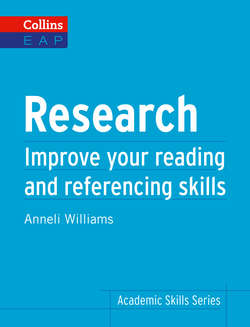Читать книгу Research: B2+ - Anneli Williams - Страница 45
Recognizing academic texts
ОглавлениеFrom time to time you will come across texts which appear to be written by authors with academic credentials but which are still not appropriate for use in your essay because they have not been written for a scholarly audience. It is therefore important to be able to recognize whether a text is appropriate by looking at the way it is written.
Exercise 4
Read the text below. Do you think it has been written for an academic audience? Why or why not?
‘We’ve all had experience of generous behaviour – people helping others without expecting something in return. We naturally assume that altruism is a virtue that we learn from our parents when we are children. ‘Share your toys … Be nice … Let your little brother go first …’ But science says that altruism is probably instinctive.
Fascinating studies of the chimp, our closest relative, have produced evidence that altruism is a genetic trait. Chimps don’t teach their offspring to be generous, but scientists Felix Warneken and Michael Tomasello from the Max Planck Institute for Evolutionary Anthropology in Leipzig, Germany have discovered that chimps do give other chimps a hand, even ones they don’t know, without expecting a reward.’
When authors write in an academic style for an academic audience, they are more likely to:
support opinions with evidence
refer to other authors by surname (for example, ‘Davis’ rather than ‘John Davis’ or ‘Mr Davis’)
give bibliographic information about works cited (for example, ‘Davis (2009: 24) states that …’
use ‘objective’ language (for example, ‘It is often said that …’ rather than ‘We often say that …’
use formal language (for example ‘numerous’ rather than ‘lots of’)
use precise language
use noun phrases rather than verbs (for example, ‘excessive alcohol consumption’ rather than ‘drinking too much alcohol’)
Glossary
noun phrase A noun phrase is a noun or pronoun, or a group of words based on a noun or pronoun.
and less likely to:
make claims that are not backed up by evidence
make exaggerated claims or categorical statements, that is statements that do not have exceptions (for example ‘everyone likes to have fun’)
refer to other authors by their full names or first names, or use titles such as ‘Dr’ or ‘Mrs’
use emotive words, for example ‘fantastic’, ‘dreadful’
use personal pronouns ‘I’ and ‘you’
use slang or informal expressions
use contractions such as ‘isn’t’ or ‘won’t’
begin sentences with ‘and’ or ‘but’
use certain punctuation marks such as the dash (-) or the exclamation mark (!).
Exercise 5
Look again at the text in Exercise 4 and identify the features that make it relatively informal in style.
1 What personal pronouns does the writer use?
2 How does the writer refer to other researchers?
3 What forms of punctuation are there that do not normally appear in more formal texts?
4 What contractions does the writer use?
5 Which words have been abbreviated?
6 Does the writer use any vague or imprecise expressions? If so, what are they?
7 Does the writer use language that is informal or emotive? If so, what examples can you fi nd?
8 What categorical expression does the writer use?
Now compare it with the text below, which has been written in a more academic style.
Altruistic behaviour, that is the offer of assistance to others without the motive of personal gain, is often said to be a characteristically human trait (Carter, 1989; Ericson, 1994). Moreover, it is commonly assumed that children learn to behave altruistically from their parents (Carter, 2004). However, the fi ndings of recent studies of chimpanzee behaviour suggest that altruism may be more instinctive than previously thought. Warneken and Tomasello (2006), for example, have documented numerous instances of chimpanzees assisting other chimpanzees to locate a food source without the expectation of a reward.
